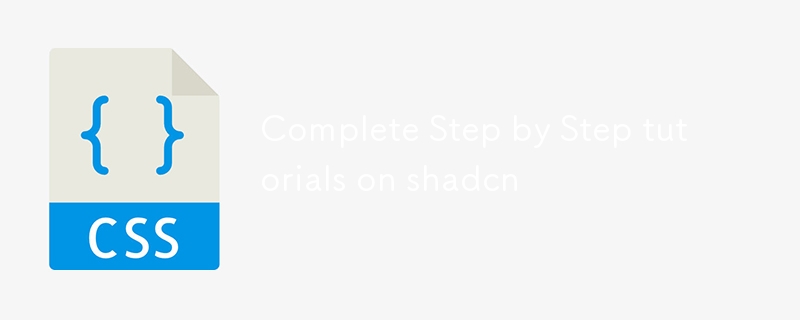

美しいユーザー インターフェイスをゼロから作成するのに膨大な時間を費やすことにうんざりしていませんか? ?もう探す必要はありません。強力な UI コンポーネント ライブラリである Shadcn は、Web 開発プロセスに革命をもたらします。熟練した開発者であろうと、初心者であろうと、Shadcn はプロジェクトを次のレベルに引き上げることができる事前構築済みコンポーネントの宝庫を提供します。
しかし、どこから始めればよいでしょうか? ? UI ライブラリの世界は圧倒的であり、新しい世界に飛び込むのは気が遠くなるかもしれません。そのため、Shadcn に関するこの包括的なガイドを作成しました。インストールから高度なテクニックまで、各ステップを順を追って説明します。このチュートリアルを終えるまでに、クライアントとユーザーの両方に感動を与える素晴らしいインターフェイスを簡単に作成できるようになります。
Shadcn の可能性を最大限に引き出す準備はできていますか?このエキサイティングな旅に一緒に乗り出しましょう!まず Shadcn とは何なのかを理解することから始め、次にインストール、コア コンポーネント、高度なテクニックに進み、最後にそれらをすべて実際のプロジェクトに組み込んでいきます。しっかり準備をしましょう – UI をマスターするための道が今始まります! ??
Shadcn は、その柔軟性と使いやすさで開発者の間で注目を集めている最先端の UI コンポーネント ライブラリです。 React 上に構築された Shadcn は、最新の Web アプリケーションの構築プロセスを大幅に合理化できる、美しくデザインされ、アクセスしやすく、カスタマイズ可能なコンポーネントのコレクションを提供します。
Shadcn の主な利点は次のとおりです。
Shadcn を使い始めるには、開発環境をセットアップする必要があります。ステップバイステップのガイドは次のとおりです:
npm install @shadcn/ui # or yarn add @shadcn/ui
Shadcn には、他の UI ライブラリとは一線を画すさまざまな機能が満載されています。
| Feature | Description |
|---|---|
| Component Library | A comprehensive set of pre-built, customizable UI components |
| Theming | Powerful theming capabilities for consistent design across your application |
| Responsive Design | Components that adapt seamlessly to different screen sizes |
| Dark Mode Support | Built-in support for dark mode, enhancing user experience |
| TypeScript Support | Full TypeScript support for improved type safety and developer productivity |
Some of the core components offered by Shadcn include:
These components serve as building blocks for creating complex user interfaces, allowing developers to focus on application logic rather than reinventing the wheel for common UI elements.
By leveraging Shadcn's powerful features and comprehensive component library, developers can significantly reduce development time while maintaining high-quality, accessible, and visually appealing user interfaces. As we move forward, we'll explore how to install and set up Shadcn in your project, providing you with the foundation to start building amazing web applications.
Now that we've explored what Shadcn is and its capabilities as a powerful UI component library, let's dive into the practical aspects of getting started with Shadcn installation. This section will guide you through the process of setting up Shadcn in your project and using your first component.
To begin your journey with Shadcn, you'll need to install it in your project. You can do this using either npm or yarn, depending on your preference. Here's how to install Shadcn:
Using npm:
npm install @shadcn/ui
Using yarn:
yarn add @shadcn/ui
Once the installation is complete, you're ready to start configuring Shadcn in your project.
After installing Shadcn, you'll need to configure it in your project. This involves setting up the necessary files and dependencies. Here's a step-by-step guide
module.exports = {
darkMode: ["class"],
content: [
'./pages/**/*.{ts,tsx}',
'./components/**/*.{ts,tsx}',
'./app/**/*.{ts,tsx}',
'./src/**/*.{ts,tsx}',
],
theme: {
extend: {},
},
plugins: [require("tailwindcss-animate")],
}
Create a globals.css file in your styles directory and add the following:
@tailwind base; @tailwind components; @tailwind utilities;
Import the globals.css file in your main application file (e.g., _app.tsx for Next.js).
Now that Shadcn is installed and configured, let's import and use your first component. We'll use the Button component as an example:
Import the Button component in your desired file:
import { Button } from "@shadcn/ui/button"
Use the Button component in your JSX:
<Button variant="outline">Click me</Button>
Here's a comparison of some common Button variants you can use:
| Variant | Description | Use Case |
|---|---|---|
| default | Standard button | General purpose |
| outline | Button with outline | Secondary actions |
| ghost | Transparent button | Subtle actions |
| link | Button that looks like a link | Navigation within tex |
By following these steps, you've successfully installed Shadcn, configured it in your project, and used your first component. This sets the foundation for exploring more of Shadcn's core components and building more complex UI elements in your project.
Next, we'll delve deeper into Shadcn's core components, examining their features and how to customize them to fit your specific needs.
Now that we've covered the installation process, let's dive into the heart of Shadcn by exploring its core components. These building blocks are essential for creating stunning and functional user interfaces.
Shadcn provides intuitive navigation components that enhance user experience. The menu and dropdown components are particularly useful for creating organized and interactive navigation systems.
Here's an example of a simple dropdown implementation:
<DropdownMenu>
<DropdownMenuTrigger>Open</DropdownMenuTrigger>
<DropdownMenuContent>
<DropdownMenuItem>Option 1</DropdownMenuItem>
<DropdownMenuItem>Option 2</DropdownMenuItem>
<DropdownMenuItem>Option 3</DropdownMenuItem>
</DropdownMenuContent>
</DropdownMenu>
Modals and dialogs are crucial for displaying important information or gathering user input without navigating away from the current page. Shadcn offers a robust set of modal and dialog components that are both customizable and accessible.
To implement a basic modal, use the following code structure:
<Dialog>
<DialogTrigger>Open Modal</DialogTrigger>
<DialogContent>
<DialogHeader>
<DialogTitle>Modal Title</DialogTitle>
<DialogDescription>Modal content goes here.</DialogDescription>
</DialogHeader>
</DialogContent>
</Dialog>
The button component in Shadcn is highly versatile and can be customized to fit various design needs. It comes with several pre-defined variants and allows for easy customization.
Button variants include:
To use a button with a specific variant, simply add the variant prop:
<Button variant="primary">Click me</Button>
Customizing buttons is straightforward with Shadcn's theming system. You can modify colors, sizes, and other properties to match your design requirements.
With these core components at your disposal, you're well-equipped to start building sophisticated user interfaces. In the next section, we'll explore advanced Shadcn techniques to take your development skills to the next level.
Now that we've covered the core components of Shadcn, let's dive into some advanced techniques that will take your Shadcn skills to the next level.
Optimizing your Shadcn components can significantly improve your application's performance. Here are some key strategies:
Shadcn seamlessly integrates with various popular frameworks, enhancing your development experience. Here's how you can integrate Shadcn with some common frameworks:
One of Shadcn's strengths is its flexibility in creating custom components. Follow these steps to create your own:
Shadcn offers a powerful theming system that allows you to customize the look and feel of your components. Here's how to make the most of it:
// Example of a custom theme object
const customTheme = {
colors: {
primary: '#3498db',
secondary: '#2ecc71',
background: '#ecf0f1',
},
fonts: {
body: 'Roboto, sans-serif',
heading: 'Montserrat, sans-serif',
},
// ... other theme properties
};
By mastering these advanced Shadcn techniques, you'll be able to create more efficient, customizable, and visually appealing applications. Next, we'll explore how to apply these skills in real-world projects, putting theory into practice.
Shadcn は、魅力的で機能的なユーザー インターフェイスの作成を求める開発者に包括的なソリューションを提供します。簡単なインストール プロセスから、幅広いコア コンポーネントや高度なテクニックに至るまで、この強力な UI ライブラリは、Web アプリケーションを実現するために必要なすべてを提供します。
このガイドで概説されているステップバイステップのチュートリアルに従うことで、Shadcn をすぐにマスターし、印象的な現実世界のプロジェクトの構築を開始できます。初心者でも経験豊富な開発者でも、Shadcn の多用途性と堅牢な機能により、Shadcn は Web 開発の武器庫において貴重なツールになります。 Shadcn のパワーを活用して、UI デザイン スキルを新たな高みに高めましょう。
以上がshadcn のステップバイステップ チュートリアルを完了するの詳細内容です。詳細については、PHP 中国語 Web サイトの他の関連記事を参照してください。